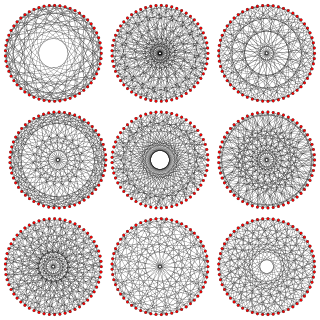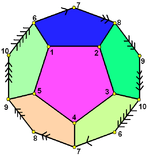57-cell
| 57-cell | |
|---|---|
 Some drawings of the Perkel graph. | |
| Type | Abstract regular 4-polytope |
| Cells | 57 hemi-dodecahedra |
| Faces | 171 {5} |
| Edges | 171 |
| Vertices | 57 |
| Vertex figure | (hemi-icosahedron) |
| Schläfli symbol | {5,3,5} |
| Symmetry group | L2(19) (order 3420) |
| Dual | self-dual |
| Properties | Regular |
In mathematics, the 57-cell (pentacontakaiheptachoron) is a self-dual abstract regular 4-polytope (four-dimensional polytope). Its 57 cells are hemi-dodecahedra. It also has 57 vertices, 171 edges and 171 two-dimensional faces. Its symmetry group is the projective special linear group L2(19), so it has 3420 symmetries.
It has Schläfli symbol {5,3,5} with 5 hemi-dodecahedral cells around each edge. It was discovered by H. S. M. Coxeter (1982).
Perkel graph
The vertices and edges form the Perkel graph, the unique distance-regular graph with intersection array {6,5,2;1,1,3}, discovered by Manley Perkel (1979).
See also
- 11-cell – abstract regular polytope with hemi-icosahedral cells.
- 120-cell – regular 4-polytope with dodecahedral cells
- Order-5 dodecahedral honeycomb - regular hyperbolic honeycomb with same Schläfli symbol {5,3,5}. (The 57-cell can be considered as being derived from it by identification of appropriate elements.)
References
- Coxeter, H. S. M. (1982), "Ten toroids and fifty-seven hemidodecahedra", Geometriae Dedicata, 13 (1): 87–99, doi:10.1007/BF00149428, MR 679218.
- McMullen, Peter; Schulte, Egon (2002), Abstract Regular Polytopes, Encyclopedia of Mathematics and its Applications, 92, Cambridge: Cambridge University Press, pp. 185–186, 502, doi:10.1017/CBO9780511546686, ISBN 0-521-81496-0, MR 1965665
- Perkel, Manley (1979), "Bounding the valency of polygonal graphs with odd girth", Canadian Journal of Mathematics, 31 (6): 1307–1321, doi:10.4153/CJM-1979-108-0, MR 553163.
- Séquin, Carlo H.; Hamlin, James F. (2007), "The Regular 4-dimensional 57-cell" (PDF), ACM SIGGRAPH 2007 Sketches, SIGGRAPH '07, New York, NY, USA: ACM, doi:10.1145/1278780.1278784
External links
- Perkel graph
- Klitzing, Richard. "Explanations Grünbaum-Coxeter Polytopes".
This article is issued from Wikipedia - version of the 1/15/2015. The text is available under the Creative Commons Attribution/Share Alike but additional terms may apply for the media files.